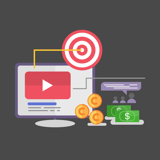Index Content
what do we all want? More customers, and when do we want them? Now.
Speaking of the 4 phases of Inbound Marketing, to receive, first you have to deliver. You won't get customers just by making a wish or having the most beautiful website in the world. In In Inbound Marketing it's exactly the same: to get visitors to your website, publish valuable content; to convert strangers into leads, use an attractive landing page; to close customers, offer a personalised experience; to build customer loyalty, nurture them. And so on and so forth.
If you want to attract potential customers, stay tuned to this post, because we are going to tell you how to achieve it through a strategy based on relevant content for each of the stages of the buyer's journey.
It's not magic, it's Inbound.
4 phases of any Inbound strategy
Before you continue, we would like to remind you what Inbound Marketing is. It is a methodology that combines marketing techniques and non-intrusive advertising to contact the user at the beginning of the buying process and accompany them until the final transaction. How? Through content adapted to each of the phases and to the user's profile.
Now we are going to tackle in depth a fundamental topic without which you would not be able to fully understand the Inbound methodology.
do you have a pen and paper handy? Take note:
-
Traffic attraction
Our objective in this phase is to attract and direct the user to our website so that they can find useful information that allows them to know and understand their need or problem. To do this, we are going to use different techniques:
- Content marketing: this is the vehicle through which we attract and deliver value to the user. Valuable information travels in it and it is a very useful tool to generate traffic and sales. Infographics, videos, posts, eBooks or whitepapers are some of the protagonists in this phase.
- Distribution on social networks: The power is also in the social networks. What would the content be if nobody was there to read it? Your activity on Facebook, Instagram or LinkedIn, the links you share, the biography of your profile, etc., not only expose you, but also directly influence the positioning of your content. Through the networks you can give greater visibility to your posts, as well as interact with the public directly.
- SEO (Search Engine Optimisation) is the process of improving the visibility of your website in the organic results of search engines. Some tips? Respect branding as an SEO tool, use keywords in your content, add a meta-description, use long texts, take care of the links, don't use duplicate content, etc.
- Advertising: Although organic positioning is our star channel, we can always use paid online advertising methods (PPC) in a complementary way, to attract more potential users.
The aim is to rank our content in Google and direct users to our website. Are you ready to move forward?
-
Conversion to lead
In this phase we want to start the process of converting strangers or visitors into leads or sales opportunities. In other words, visits are converted into registrations and, as a result, we have their data stored in a database. This information is achieved through the offer of relevant content that users can download in exchange for filling out a form with their details. Ideally, we should ask for, at least, name and email address. It is advisable not to put too many fields, as this could generate rejection in the user. Now that we have a database with the information of our leads, it is time to get to work. They have downloaded the content for a reason and we want to find out why.
not so fast!
You have achieved a certain number of leads, but that doesn't mean that they are all at the same point of purchase. Some sales opportunities may be colder, others more temperate and others much closer to the sale. Let's find out with a previous phase of lead qualification and maturation. That is, lead nurturing and lead scoring. The objective is to calibrate where the sales opportunities are in the strategy. And according to that, deliver adapted content.
-
Customer closure.
What in the beginning was just a name and an email address, is now a sales opportunity ready to become a customer. And for this, we can use the HubSpot CRM, email marketing (or workflows or automation flows). They are good allies!
The workflow in an Inbound Marketing strategy consists of limiting the attraction and conversion to leads in order to create a database of potential customers. Then, we will accompany them throughout the purchase cycle, educating and maturing them, so that, at the right time, we can send them our commercial offer.
-
Loyalty
It's not the end, it's the beginning, so why did we put it at the end? You see, closing a customer is just the beginning of a long-term relationship that you should take care of like gold.
After all the effort, time and effort put into the sale, you don't want the customer to forget about you. It's time to make them repeat the purchase whenever they need your product or service. Or better yet, to recommend you to other customers. That's why you need to build loyalty and strengthen the bond that unites you. How? By taking care of them, offering them personalised content through email marketing, sending them information of interest, offers, discounts and much more. If after the purchase you continue to provide value, they will be more than willing to buy from you.
Our 6 Inbound recommendations
Now that you know the 4 phases of Inbound Marketing, step by step, we want to leave you our legacy, or rather, the tips that you should keep in mind in your Inbound Marketing strategy so you can always take them with you. Here they go!
- Understand your target before creating content: What motivates them? What are their concerns? Why do they share what they share? What content are they interested in?
- Know the key concepts of the strategy, from the conversion funnel (flywheel), the buyer persona and the buyer journey, to social media and measuring results.
- Define KPIs and measure the results of your marketing actions: what works and what doesn't? How to improve your strategy?
- Give content the value it deserves, otherwise no one will do it for you.
- Be realistic and don't set your goals too high. It's better to go slowly, with your feet on the ground and with SMART goals (specific, measurable, achievable, relevant and temporary).
- Hire an agency specialised in Inbound Marketing if you don't know where to start your strategy.
if you have any doubts, let them go and call us when you are ready to clear them up. Yes, yes, you read that right, because at Occam Digital Agency we can be your allies.




